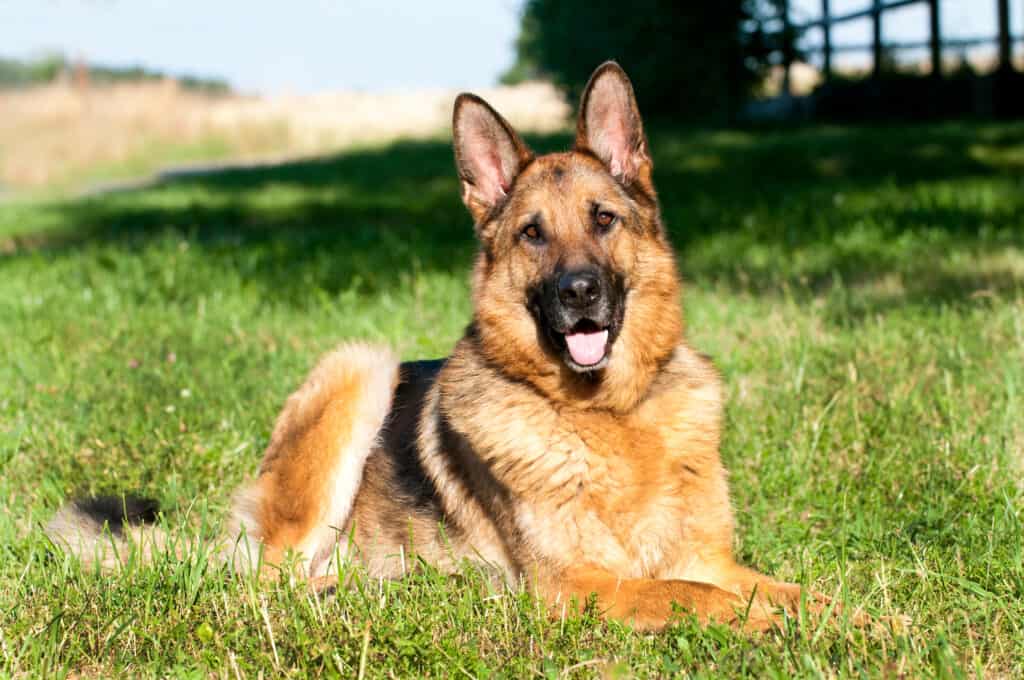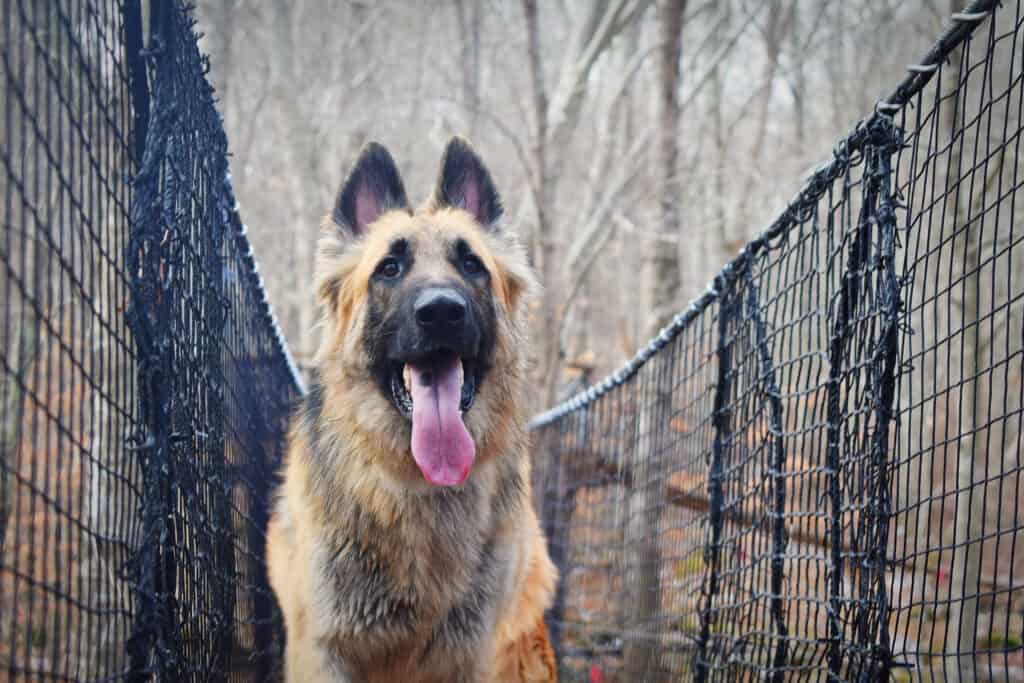German shepherds and Shiloh shepherds are known for their high intelligence and work ethic. These dogs look remarkably similar, but there are some key differences between the two breeds. German shepherds stand out because of their loyalty and guarding instincts, making them a steadfast and loving family pet. Shiloh shepherds are more mellow and peaceful compared to the alert nature of a German shepherd, and they get along with other dogs more easily. Let’s look at the eight key differences between German shepherds vs. Shiloh shepherds.
Shiloh Shepherd vs. German Shepherd: A Comparison
| COMPARISON | GERMAN SHEPHERD | SHILOH SHEPHARD |
| Height | 22-26 inches | 28-30 inches |
| Weight | Males: 65-90 lbs. Females: 50-70 lbs. | Males: 100-130 lbs. Females: 80-100 lbs. |
| Coat Type | Dense double coat with a soft undercoat | Smooth/short-haired or plush/long-hair |
| Colors | Black with tan, red, or silver Jet-black | Brown, red, black, white, gold, or silver |
| Temperament | Courageous, Obedient, Intelligent, Loyal | Intelligent, Self-confident, Friendly, Calm |
| Social Needs | Average | Above Average |
| Life Expectancy | 7-10 Years | 9-11 Years |
| Health Problems | Degenerative Myelopathy Elbow and Hip Dysplasia Bloat | Allergies Hip Dysplasia Exocrine Pancreatic Insufficiency |
Key Differences German Shepherd vs. Shiloh Shepherd

German shepherds have a range of coat thickness, but the American Kennel Club only recognizes the medium-length double coat.
©Dora Zett/Shutterstock.com
When comparing a Shiloh shepherd to a German shepherd, a couple key differences become apparent. On the whole, Shiloh shepherds are larger than German shepherds of the same sex. Shilohs have a wolfish appearance, due to their more triangular eyes and ears. Through selective breeding for a more family-friendly dog, Shilohs are calmer and more social than German shepherds. German shepherds, however, don’t shed nearly as much as Shilohs; their coats require much less maintenance. Shiloh shepherds need a lot of brushing to maintain their soft coats, and they are big seasonal shedders. Additionally, German shepherds make fantastic working dogs, as they are highly intelligent and have great stamina and agility.
Height
Overall, Shiloh shepherds are bigger than German shepherds of the same sex. The average height of a Germans shepherd is 22-26 inches; whereas, the Shiloh shepherd ranges from 28-30 inches. Breeders crossed the German shepherd with the Alaskan malamute for a dog with a calmer temperament and fewer health issues than the German shepherd. The result was the Shiloh shepherd! Besides the change in temperament, the crossbreeding for the Shiloh shepherds resulted in a larger breed. Shilohs are 4 to 6 inches taller on average than German shepherds.
Weight
Because the Shiloh shepherd breed is much taller than the German shepherds, Shilohs are also heavier than their German counterparts. Male German shepherds are 65-95 pounds, whereas male Shiloh shepherds are 100-130 pounds. Likewise, female German shepherds are 50-70 pounds, and female Shiloh shepherds are 80-100 pounds.
According to the breeder sizing system, a large dog breed must weigh at least 50 pounds and be at least 24 inches tall. Thus, both the Shiloh and German shepherds are considered large dog breeds.
Coat Types
Shilohs have either smooth/short-haired coats or plush/long-haired coats. Shilohs need daily brushing, as they shed a lot. Thus, they are not an ideal breed for those with allergies. This breed will “blow its coat” or shed their coats in big tufts of fur. This happens twice a year: once in the spring, as Shilohs shed their heavy winter coats for the summer, and another lighter one in the fall.
German shepherds have a range of coat thickness, but the American Kennel Club only recognizes the medium-length double coat. The double coat is very dense, thus giving German shepherds a sleek, smooth look. German shepherds only need to be brushed three or four times a week to remove loose hairs and keep the coats looking shiny.
Colors
German shepherds are known for their “black saddle” coloring on their back. The most popular appearances of the German shepherds are tan and black, red and black, silver and black, and jet-black. Shilohs don’t usually have the “black saddle,” but they usually have a combination of two or more colors. The most common Shiloh coloring is brown, red, black, white, gold, or silver.
Characteristics

As shepherd dogs, Shilohs are highly intelligent and can be trained for many sorts of jobs.
©Brendon Freitas/Shutterstock.com
Temperament
Shiloh shepherds are calmer than German shepherds, thanks to their Alaskan malamute genetics. As shepherd dogs, Shilohs are highly intelligent and can be trained for many sorts of jobs. Some common careers for Shiloh shepherds include guide dog, search and rescue, service dog, etc. Because they are so loyal and affectionate, they get very anxious when left alone for too long and can exhibit stress behaviors such as chewing, digging, or barking.
German shepherds are also highly intelligent and get a lot of fulfillment from completing “jobs.” Because they are protective, German shepherds are often recruited for police dogs, military service, search and rescue, and tracking. German shepherd are also highly loyal, which makes them affectionate family pets. However, because of their loyalty and protectiveness, they take awhile to warm up to strangers. These dogs get along well with humans and other animals, but they are more aggressive towards other dogs than Shilohs. Early socialization of puppy German shepherds with other dogs, however, will help this. On the whole, German shepherds are extremely affectionate to their families.
Social Needs
Both breeds are very sociable and enjoy being around their humans and animal friends. As mentioned before, being left alone for too long will cause anxiety, boredom, and frustration in these breeds. That can lead to chewing things in the house or incessant barking. If you work a lot outside of the home, these are not the dog breeds for you.
Both Shilohs and German shepherds need big spaces to live in and don’t do well with apartment living. They also require a lot of exercise—both physical and mental challenges or “jobs.” German Shepherds, however, need difficult tasks to receive the satisfaction of completing a job. They are very focused, intelligent dogs, and if not challenged adequately, they will lapse into frustration or depression.
Health Factors
Life Expectancy
A German shepherd’s life expectancy is from seven to 10 years, and a Shiloh shepherd’s life expectancy is from 9 to eleven years. Although, some Shilohs have reached 14 years of age. Shiloh shepherds have a longer life expectancy because they have a lower risk of musculoskeletal issues compared to German shepherds.
Health Problems
One health risk for German shepherds is degenerative myelopathy, a disease which affects the spinal cord, eventually resulting in weakness and paralysis of the hind legs. German shepherds can also experience elbow and hip dysplasia. The dysplasia means that the ball and socket structure of the joint do not fit properly together. Instead, the joint rubs together, eventually resulting in the loss of function of the joint.
One other condition to watch out for is bloat. That is when the stomach fill with air, and because of the pressure, blood begins to pool at the back end of the body, sending the dog into shock. In cases of bloat, a dog must be treated right away.
A Shiloh shepherd’s breeding makes hip dysplasia less of a risk, but it is always a risk for large dog breeds. Degenerative myelopathy and bloat are also common risks for larger dog breeds. Exocrine Pancreatic Insufficiency (EPI) is also a risk, though it has a genetic component (runs in families, rather than specific to the breed). EPI occurs when the cells that produce digestive hormones aren’t working.
Finally, Shiloh shepherds may experience chronic allergies. Their itchy skin may develop a bacterial infection due to the constant scratching. Good grooming and quality dog food helps. There are other, less common health risks for Shilohs, which you can read more about here.
Wrapping Up Shiloh Shepherd vs. German Shepherd
Both these breeds are smart and loyal. They are perfect breeds to join you for an active life full of adventure. Although Shiloh shepherds are a calmer family dog, both dog breeds are protective of their families and love being part of a social circle.
The photo featured at the top of this post is ©
Ready to discover the top 10 cutest dog breeds in the entire world?
How about the fastest dogs, the largest dogs and those that are -- quite frankly -- just the kindest dogs on the planet? Each day, AZ Animals sends out lists just like this to our thousands of email subscribers. And the best part? It's FREE. Join today by entering your email below.
Thank you for reading! Have some feedback for us? Contact the AZ Animals editorial team.






